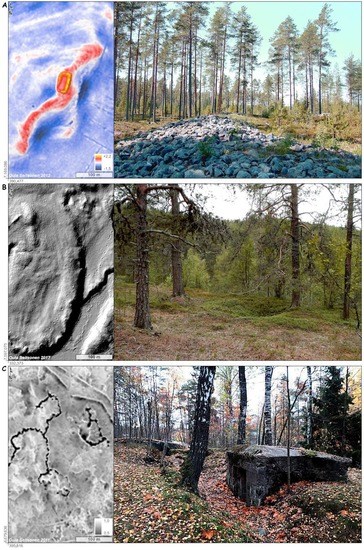Employment, Utilization, and Development of Airborne Laser Scanning in Fenno-Scandinavian Archaeology—A Review
Abstract
:1. Introduction
- To promote and convey how ALS has been used for archaeological purposes in the Fenno-Scandinavian region
- To put this into an international context
- To identify knowledge gaps
- To point out some future perspectives
2. Literature Review
2.1. Method
2.2. ALS Data Availability
2.3. Archaeologies, Topographies, and Landscapes
2.4. Identifying, Mapping, and Documenting Cultural Features
2.5. ALS and Cultural Heritage Management
2.6. Semi-Automated Detection of Cultural Features
2.7. Monitoring Cultural Heritage
2.8. Combined Use of Remote Sensing Techniques
2.9. Landscape Studies, Improved Landscape Understanding
2.10. ALS from Drones
2.11. ALS and Community Archaeology/Local Engagement
3. Discussion
4. Conclusions
Author Contributions
Funding
Conflicts of Interest
References
- Holden, N. Digital airborne remote sensing: The principles of LiDAR and CASI. AARGNews 2001, 22, 23. [Google Scholar]
- Motkin, D. An assessment of LIDAR for archaeological use. AARGNews 2001, 22, 24–25. [Google Scholar]
- Shell, C.; Roughley, C. Exploring the Loughcrew landscape: A new approach with airborne lidar. Archaeol. Irel. 2004, 18, 22–25. [Google Scholar]
- Bewley, R.H.; Crutchley, S.P.; Shell, C.A. New light on an ancient landscape: Lidar survey in the Stonehenge World Heritage Site. Antiquity 2005, 79, 636–647. [Google Scholar] [CrossRef]
- Bofinger, J.; Kurz, S.; Schmidt, S. Ancient maps—Modern data sets: Different investigative techniques in the landscape of the Early Iron Age princely hill fort Heuneburg, Baden-Württemberg. In From Space to Place: 2nd International Conference on Remote Sensing in Archaeology; Campana, S., Forte, M., Eds.; British Archeological Review; Archaeopress: Oxford, UK, 2006; Volume 1568, pp. 87–92. [Google Scholar]
- Risbøl, O.; Gjertsen, A.K.; Skare, K. Airborne laser scanning of cultural remains in forests—Some preliminary results from a Norwegian project. In From Space to Place: 2nd International Conference on Remote Sensing in Archaeology; Campana, S., Forte, M., Eds.; British Archaeological Review; Archaeopress: Oxford, UK, 2006; Volume 1568, pp. 107–112. [Google Scholar]
- Clemmensen, N.C. 2010 DHM—den digitale højdemodel—Reliefkortet. In Oldtidsagre i Danmark, Sjælland, Møn og Lolland-Falster; Nielsen, V., Ed.; Jysk Arkæologisk Selskab, Aarhus Universitetsforlag: Aarhus, Denmark, 2010; pp. 25–27. ISBN 9788788415643. [Google Scholar]
- Nielsen, V. (Ed.) Oldtidsagre i Danmark—Sjælland, Møn og Lolland-Falster; Jysk Arkæologisk Selskabs Skrifter, Aarhus University Press: Århus, Denmark, 2010. [Google Scholar]
- Clemmensen, N.C. 2012 Landskabslæsning. Skalk 2012, 3, 24–27. [Google Scholar]
- Alexander, B.; Jansson, J.; Söderman, U. Laserskanning Från Flyg Och Fornlämningar i Skog; Rapport 2009:09; Kulturmiljöenheten. Länsstyrelsen Dalarnas län: Falun, Sweden, 2009. [Google Scholar]
- Kurri, I.; Haimila, M. Metsää syvemmältä—Lidar-aineisto arkeologian apuvälineenä. Muinaistutkija 2010, 1, 63–68. [Google Scholar]
- Seitsonen, O. Juoksuhautoja ja asumuspainanteita: Kokemuksia lidarlaserkeilausaineiston käytöstä kenttäarkeologiassa. Muinaistutkija 2011, 2, 36–44. [Google Scholar]
- Doneus, M.; Briese, C.; Fera, M.; Janner, M. Archaeological prospection of forested areas using full-waveform airborne laser scanning. J. Archaeol. Sci. 2008, 35, 882–893. [Google Scholar] [CrossRef]
- Doneus, M.; Briese, C. Airborne laser scanning in forested areas—Potential and limitations of an archaeological prospection technique. In Remote Sensing for Archaeological Heritage Management; Cowley, D.C., Ed.; EAC Occasional Paper No. 5; Europae Archaeologia Consilium (EAC): Brussels, Belgium, 2011; pp. 59–76. [Google Scholar]
- Devereux, B.J.; Amable, G.S.; Crow, P.; Cliff, A.D. The potential of airborne lidar for detection of archaeological features under woodland canopies. Antiquity 2005, 79, 648–660. [Google Scholar] [CrossRef]
- Gallagher, J.M.; Josephs, R.L. Using LiDAR to detect cultural resources in a forested environment: An example from Isle Royale National Park, Michigan, USA. Archaeol. Prospect. 2008, 15, 187–206. [Google Scholar] [CrossRef]
- Johnson, K.M.; Ouimet, W.B. Rediscovering the lost archaeological landscape of southern New England using airborne light detection and ranging (LiDAR). J. Archaeol. Sci. 2014, 43, 9–20. [Google Scholar] [CrossRef]
- Georges-Leroy, M. Airborne Laser Scanning for the management of archaeological sites in Lorraine (France). In Remote Sensing for Archaeological Heritage Management; Cowley, D.C., Ed.; EAC Occasional Paper No. 5; Europae Archaeologia Consilium (EAC): Brussels, Belgium, 2011; pp. 229–234. [Google Scholar]
- Riksantikvarieämbetet & Skogsstyrelsen. Redovisning Av 2016 Års Arbete Inom Projektet Kvalitetssäkring Skog Och Historia. URL 2020-01-16. 2016. Available online: https://www.raa.se/app/uploads/2017/06/2016_SH_rapport_inklBilagor.pdf (accessed on 16 January 2020).
- Norwegian Mapping Authority. Available online: https://kartverket.no/Prosjekter/Nasjonal-detaljert-hoydemodell/ (accessed on 8 January 2020).
- Norwegian Mapping Authority. Available online: https://hoydedata.no/LaserInnsyn/ (accessed on 8 January 2020).
- Grubbmo, E.; Andersen, O.; Hagen, I.; Gaarud, J.E. Samfunnsøkonomisk Analyse Av Nasjonal Detaljert Høydemodell. Rapport til Kartverket. Available online: https://kartverket.no/globalassets/arkiv/kart/nasjonal-hoydemodell/rapport---samfunnsokonomisk-analyse-nasjonal-detaljert-hoydemodell.pdf (accessed on 10 December 2019).
- SDFE/Styrelsen for Dataforsyning og Effektivisering. December 2009, Oktober 2014: Produktspecifikation Danmarks Højdemodel DHM-2007/Terræn; Miljøministeriet, Kort & Matrikelstyrelsen: København, Denmark, 2014. [Google Scholar]
- Clemmensen, N.C. Fra laser til landkort. Arkæologisk Forum 2010, 23, 27–30. [Google Scholar]
- SDFE/Styrelsen for Dataforsyning og Effektivisering. 2016: Produktspecifikation Danmarks Højdemodel DHM/Terræn; Miljøministeriet, Kort & Matrikelstyrelsen: København, Denmark, 2016. [Google Scholar]
- Danish Geodata Agency. Available online: www.sdfkort.dk/spatialmap (accessed on 30 November 2019).
- Lantmäteriet. Nationell Höjdmodell, Produktionsstatus. Available online: https://www.lantmateriet.se/External/geolex/bild_hojd/utfall/utfall_nh.pdf (accessed on 27 April 2020).
- Lantmäteriet. Produktbeskrivning: Höjdmodell Visning. Dokumentversion 1.4; 2019. Available online: https://www.lantmateriet.se/globalassets/kartor-och-geografisk-information/geodatatjanster/pb_hojd_visn_v1.1.0_1.4.pdf (accessed on 26 January 2020).
- Lantmäteriet: Produktbeskrivning: Höjdmodell Nedladdning. Dokumentversion 1.4. Available online: https://www.lantmateriet.se/globalassets/kartor-och-geografisk-information/geodatatjanster/hojdmodell_nedladdning_v1.0_1.4.pdf (accessed on 26 January 2020).
- Riksantikvarieämbetet, Fornsök. Available online: https://www.raa.se/hitta-information/fornsok/ (accessed on 27 April 2020).
- Lantmäteriet. Product Description: Laser data—Laserdata Skog. Document Version 1.2. 2019-10-01. Available online: https://www.lantmateriet.se/globalassets/kartor-och-geografisk-information/hojddata/lidar_data_skog.pdf (accessed on 26 January 2020).
- Finnish National Land Service. Available online: https://tiedostopalvelu.maanmittauslaitos.fi/tp/kartta (accessed on 24 December 2019).
- Statistics Norway. Available online: https://www.ssb.no/en/ (accessed on 28 January 2020).
- Nielsen, V.; Clemmensen, N.C. (Eds.) Oldtidsagre i Danmark, Fyn og Langeland; Jysk Arkæologisk Selskab, Aarhus University Press: Århus, Denmark, 2015. [Google Scholar]
- Levin, G.; Normander, B. Arealanvendelse i Danmark Siden Slutningen af 1800-Tallet. Faglig Rapport fra DMU nr. 682; Danmarks Miljøundersøgelser. Aarhus Universitet: Aarhus, Denmark, 2008; ISBN 978-87-7073-059-4. [Google Scholar]
- Olesen, L.H.; Mauritsen, E.S. Skjulte Fortidslandskaber i Skov og Hede Afsløres Med Detaljerede Laserscanninger. Holstebro Museums Årsskrift 2012, 24–40. [Google Scholar]
- Fund & Fortidsminder. Available online: http://www.kulturarv.dk/fundogfortidsminder/ (accessed on 30 November 2019).
- Klinkby, K.J.; Klingenberg, M.; Henningsen, H. Fredede Fortidsminder i Midt- og Vestjylland. Resultaterne af fem års Tilsyn; Holstebro Museum: Holstebro, Denmark, 2014. [Google Scholar]
- Statistics Sweden. Land Use in Sweden, 7th ed.; Markanvändningen i Sverige, sjunde utgåvan; SCB, Statistiska Centralbyrån Bibliotek: Stockholm, Sweden, 2019.
- Framstad, E.; Berglund, H.; Gundersen, V.; Heikkilä, R.; Lankinen, N.; Peltola, T.; Risbøl, O.; Weih, M. Increased Biomass Harvesting for Bioenergy: Effects on Biodiversity, Landscape Amenities and Cultural Heritage Values; Framstad, E., Ed.; TemaNord, Nordic Council of Ministers: Copenhagen, Denmark, 2009; Volume 591, pp. 1–161. ISBN 978-92-893-1962-1. [Google Scholar]
- Statistics Finland. Available online: https://www.stat.fi/index_en.html (accessed on 7 January 2020).
- Seitsonen, O.; Moshenska, G. Who owns the ‘wilderness’? Indigenous Second World War landscapes in Sápmi, Finnish Lapland. In Conflict Landscapes: Materiality and Meaning in Contested Places; Saunders, N.J., Cornish, P., Eds.; Routledge: Abingdon, UK, 2020. [Google Scholar]
- Seitsonen, O. Archaeologies and Heritage of Hitler’s Arctic War: Second World War German Material Legacy in Finnish Lapland; Routledge: Abingdon, UK, 2020. [Google Scholar]
- Risbøl, O. Airborne laser scanning of cultural features in Norwegian forests—Preliminary results from a pilot project. In Past from the Air: Aerial Archaeology and Landscape Studies in Northern Europe. Papers from the International Seminar Held at Klaipéda University, 16–20 November 2005; Department of Cultural Heritage Protection, Klaipéda University: Klaipėda, Lithuania, 2007; pp. 57–70. [Google Scholar]
- Risbøl, O. Neglected cultural heritage in Norwegian forests—State of affairs, challenges and solutions. In Archaeological Sites in Forests: Strategies for their Protection; Irlinger, W., Suhr, G., Eds.; Volk Verlag: Munich, Germany, 2017; Volume 14, pp. 25–31. [Google Scholar]
- Holmsen, A. Eidsvoll Bygds Historie: Bygdehistorien til Omkring 1700; bind I, 1. del; Eidsvoll Bygdebokkomité: Oslo, Norway, 1961. [Google Scholar]
- Holmsen, A. Eidsvoll Bygds Historie: Bygdehistorien 1700–1914; bind I, 2. del; Eidsvoll Bygdebokkomité: Oslo, Norway, 1961. [Google Scholar]
- Risbøl, O. Fugleperspektiv på kulturminner: Bruk av flybåren laserskanning i arkeologien. Viking Nor. Arkeol. Årbok 2009, 72, 211–226. [Google Scholar]
- Skare, K. Som lys fra oven. En introduksjon til flybåren laserskanning. Primit. Tider Arkeol. Tidsskr. 2011, 13, 101–112. [Google Scholar]
- Pilø, L. Opptakt—FoU Delprosjekt: Utredning Av Egnethet Av HD-Lidarkartlegging Som Arbeidsverktøy I Kulturminneforvaltningen; Kulturhistoriske skrifter 2013/1; Oppland Fylkeskommun: Lillehammer, Norway, 2013; pp. 1–51.
- Risbøl, O. Towards an improved archaeological record through the use of airborne laser scanning. In Space, Time and Place. 3rd International Conference on Remote Sensing in Archaeology; Forte, M., Campana, S., Liuzza, C., Eds.; British Archaeological Review: Oxford, UK, 2010; Volume 2118, pp. 105–112. [Google Scholar]
- Nesbakken, A.; Risbøl, O. Med laserblikk på villreinfangst i Varanger. OTTAR 2011, 2, 41–47. [Google Scholar]
- Bollandsås, O.M.; Risbøl, O.; Ene, L.T.; Nesbakken, A.; Gobakken, T.; Næsset, E. Using airborne small-footprint laser scanner data for detection of cultural remains in forests: An experimental study of the effects of pulse density and DTM smoothing. J. Archaeol. Sci. 2012, 39, 2733–2743. [Google Scholar] [CrossRef]
- Risbøl, O.; Gustavsen, L. Håndbok. Bruk av luftbåren laserskanning (lidar) i arkeologien. Riksantikvaren 2016, 1–61. [Google Scholar] [CrossRef]
- Risbøl, O.; Gjertsen, A.K.; Skare, K. Flybåren laserskanning og kulturminner i skog: Ny teknologi i arkeologiens tjeneste. Kart og Plan 2007, 2, 78–90. [Google Scholar]
- Risbøl, O.; Bollandsås, O.M.; Nesbakken, A.; Ørka, H.O.; Næsset, E.; Gobakken, T. Interpreting cultural remains in airborne laser scanning generated digital terrain models: Effects of size and shape on detection success rates. J. Archaeol. Sci. 2013, 40, 4688–4700. [Google Scholar] [CrossRef]
- Olesen, L.H.; Mauritsen, E.S.; Broch, M. Luftfotoarkæologi 2. Luftfotos, Droner, Laser & Geofysik; De Kuturhistoriske Museer i Holstebro Kommune: Holstebro, Denmark, 2019. [Google Scholar]
- Olesen, L.H.; Mauritsen, E.S. Luftfotoarkæologi i Danmark; Holstebro Museum: Holstebro, Denmark, 2015. [Google Scholar]
- Lindegaard, M.R. Danmarks Oldtid i Landskabet; Lindhardt og Ringhof; Slots- og Kulturstyrelsen: København, Denmark, 2019.
- Stott, D.; Kristiansen, S.M.; Sindbæk, S.M. Searching viking age fortresses with automatic landscape classification and feature detection. Remote Sens. 2019, 11, 1881. [Google Scholar] [CrossRef] [Green Version]
- Mohtashami, S.; Willén, E. Kartering av fornminnen i skogen med fjärranalys; Arbetsrapport från Skogforsk nr. 923-2017; Skogforsk: Uppsala, Sweden, 2017. [Google Scholar]
- Skogens kulturarv i Kvarkenregionen2. Available online: http://www.skaik.eu/ (accessed on 31 December 2019).
- Andersson, B. Skogens Kulturarv i Kvarkenregionen2—Verksamheter under 2011, Västerbottens län; Arkeologisk rapport dnr 622/09; Västerbottens Museum: Umeå, Sweden, 2012. [Google Scholar]
- Olofsson, K.J. 2014 års Fornminnesinventering i Jämtlands län. Härjedalens Kommun; Rapport—Jamtli 2015:7.; Jamtli: Östersund, Sweden, 2015. [Google Scholar]
- Ulfhielm, B.; Björck, M. Inventering i Skogs Socken: Skogs Socken, Söderhamns Kommun, Hälsingland, 2015. Rapport Länsmuseet Gävleborg; Länsmuseet Gävleborg: Gävle, Sweden, 2016. [Google Scholar]
- Törnqvist, O.; Lindeberg, G. Fjärranalys för Kulturmiljövården: Underlag för Arbete Med Lägesbestämda Fornlämningar; Riksantikvarieämbetet och Metria: Stockholm, Sweden, 2014. [Google Scholar]
- Törnqvist, O. Fjärranalys för Kulturmiljövården. Steg 2: Rekommenderade Derivatprodukter och Produktionsmetoder; Riksantikvarieämbetet och Metria: Stockholm, Sweden, 2015. [Google Scholar]
- Norstedt, G.; Axelsson, A.L.; Laudon, H.; Östlund, L. Detecting cultural remains in boreal forests in Sweden using airborne laser scanning data of different resolutions. J. Field Archaeol. 2019, 1–13. [Google Scholar] [CrossRef]
- Seitsonen, O. LiDAR-kaukokartoitusaineistojen visualisointi ja analysointi: Paikkatietoalgoritmeja arkeologeille. Muinaistutkija 2013, 1, 2–16. [Google Scholar]
- Koivisto, S.; Laulumaa, V. Pistepilvessä—Metsien arkeologiset kohteet LiDAR-ilmalaserkeilausaineistoissa. Arkeologipäivät 2012, 2013, 51–67. [Google Scholar]
- Mustonen, R. Conquering the forests with lasers and social media—Finland’s National Forest Programme 2015 Cultural Heritage Survey. In Archaeological Sites in Forests: Strategies for their Protection; Irlinger, W., Suhr, G., Eds.; Volk Verlag: Munich, Germany, 2017; Volume 14, pp. 19–24. [Google Scholar]
- Stichelbaut, B.; Thomas, S.; Seitsonen, O.; Gheyle, W.; De Mulder, G.; Hemminki, V.; Plets, G. Operation Northern Light: Remote sensing of a Second World War conflict landscape in Northern Finland. In Conflict Landscapes: Materiality and Meaning in Contested Places; Saunders, N.J., Cornish, P., Eds.; Routledge: Abingdon, UK, 2020. [Google Scholar]
- Gustavsen, L.; Paasche, K.; Risbøl, O. Arkeologiske Undersøkelser: En Vurdering av Nyere Avanserte Arkeologiske Registreringsmetoder i Forbindelse med Vegutbyggingsprosjekter; Vegdirektoratet: Oslo, Norway, 2013.
- Alexander, B. Laserskanning och agrara lämningar. Agrarlämningar i det nutida samhället. Vad har gjorts och hur går vi vidare med undersökningar, värdering och handläggning av agrara lämningar. Rapport från seminariet i Jönköping 17–18 April 2013; Engman, F., Lorenzon, M., Vestbö Franzén, Å., Eds.; Jönköpings Läns Museums Skriftserie: Jönköping, Sweden, 2015; pp. 77–93. [Google Scholar]
- Carlsson, D. Ett Okänt Kulturlandskap Träder Fram. Laserkartan som Underlag för Att Registrera Fossil Åkermark; Dnr: 431-2659-2016, Region Gotland, Gotlands län. Arrendus rapport 2019:43; Arkeologisk utredning: Visby, Sweden, 2019. [Google Scholar]
- Nord, J.; Nyqvist, R.; Sandberg, C. Skogens Antikvariskt Fördolda Kulturlandskap. Ett Projekt I Samverkan Mellan Länsstyrelsen I Hallands Län, Västra Götalands Län Samt Skogsstyrelsen. 2019. Available online: https://www.lansstyrelsen.se/download/18.26f506e0167c605d56955b0d/1552577574389/2019-7%20Skogens%20antikvariskt%20f%C3%B6rdolda%20kulturlandskap.pdf (accessed on 27 April 2020).
- Risbøl, O. Kulturminner i skog – bruk av flybåren laserskanning som grunnlag for en bærekraftig forvaltning. In Kulturarv, Kulturminner og Kulturmiljøer. Presentasjoner fra NIKUs Strategiske Instituttprogrammer 2006–2010; Sætren, A., Fløisand, I., Swensen, G., Skar, B., Eds.; NIKU Tema 39; Norsk institutt for kulturminneforskning: Oslo, Norway, 2012; pp. 100–104. [Google Scholar]
- Risbøl, O.; Nesbakken, A.; Ørnelund Nilsen, J.E. Hva skogen skjuler—Kulturminneregistreringer fra lufta. Skog 2012, 5, 26–28. [Google Scholar]
- Tomter, S.; Risbøl, O. Kulturminner i skog. In Bærekraftig Skogbruk i Norge; Tomter, S.M., Dalen, L.S., Eds.; Norsk institutt for skog og landskap: Ås, Norway, 2014; pp. 230–233. [Google Scholar]
- Risbøl, O.; Gjertsen, A.K.; Skare, K. Flybåren laserskanning og registrering av kulturminner i skog. Fase 3; NIKU Rapport 22; Norsk institutt for kulturminneforskning: Oslo, Norway, 2008. [Google Scholar]
- Trier, Ø.D.; Pilø, L.H. Automatic detection of pit structures in airborne laser scanning data. Archaeol. Prospect. 2012, 19, 103–121. [Google Scholar] [CrossRef]
- Trier, Ø.D.; Pilø, L.H. Archaeological mapping of large forested areas, using semi-automatic detection and visual interpretation of high-resolution LiDAR data. In CAA2014. 21st Century Archaeology: Concepts, Methods and Tools, Proceedings of the 42nd Annual Conference on Computer Applications and Quantitative Methods in Archaeology, Paris, France, 22–25 April 2014; Archaeopress: Oxford, UK, 2015; pp. 81–86. [Google Scholar]
- Trier, Ø,D.; Zortea, M. Semi-automatic detection of cultural heritage in LiDAR data. In Proceedings of the 4th International Conference on Geographic Object-Based Image Analysis (GEOBIA), Rio de Janeiro, Brazil, 7–9 May 2012; pp. 1–6. [Google Scholar]
- Trier, Ø.D.; Zortea, M.; Tonning, C. Automatic detection of mound structures in airborne laser scanning data. J. Archaeol. Sci. 2015, 2, 69–79. [Google Scholar] [CrossRef]
- Trier, Ø.D.; Pilø, L.H.; Johansen, H.M. Semi-automatic mapping of cultural heritage from airborne laser scanning data. Sémata 2015, 27, 159–186. [Google Scholar]
- Lambers, K.; Verschoof-van der Vaart, W.B.; Bourgeois, Q.P.J. Integrating remote sensing, machine learning, and citizen science in Dutch archaeological prospection. Remote Sens. 2019, 11, 794. [Google Scholar] [CrossRef] [Green Version]
- LeCun, Y.; Bengio, Y.; Hinton, G. Deep learning. Nature 2015, 521, 436–444. [Google Scholar] [CrossRef]
- Trier, Ø.D.; Salberg, A.B.; Pilø, L.H. Semi-automatic mapping of charcoal kilns from airborne laser scanning data using deep learning. In Oceans of Data, Proceedings of the 44st Annual Conference on Computer Applications and Quantitative Methods in Archaeology, Oslo, Norway, 29 March–2 April 2016; Uleberg, E., Matsumoto, M., Eds.; Archaeopress: Oxford, UK, 2018; pp. 221–231. [Google Scholar]
- Guyot, A.; Hubert-Moy, L.; Lorho, T. Detecting Neolithic burial mounds from LiDAR-derived elevation data using a multi-scale approach and machine learning techniques. Remote Sens. 2018, 10, 225. [Google Scholar] [CrossRef] [Green Version]
- Trier, Ø.D.; Cowley, D.C.; Waldeland, A.U. Using deep neural networks on airborne laser scanning data: Results from a case study of semi-automatic mapping of archaeological topography on Arran, Scotland. Archaeol. Prospect. 2018, 26, 1–11. [Google Scholar] [CrossRef]
- Verschoof-van der Vaart, W.B.; Lambers, K. Learning to look at LiDAR. The use of R-CNN in the automated detection of archaeological objects in LiDAR data from The Netherlands. J. Comput. Appl. Archaeol. 2019, 2, 31–40. [Google Scholar] [CrossRef] [Green Version]
- Kermit, M.; Reksten, J.H.; Trier, Ø.D. Towards a National Infrastructure for Semi-Automatic Mapping of Cultural Heritage in Norway. In Oceans of Data, Proceedings of the 44st Annual Conference on Computer Applications and Quantitative Methods in Archaeology, Oslo, Norway, 29 March–2 April 2016; Uleberg, E., Matsumoto, M., Eds.; Archaeopress: Oxford, UK, 2018; pp. 159–172. [Google Scholar]
- Trier, Ø.D.; Reksten, J.H. Automated Detection of Cultural Heritage in Airborne Lidar Data. CultSearcher Operationalization; Report, SAMBA/50/19, 30 December 2019; Norsk Regnesentral/Norwegian Computing Center: Oslo, Norway, 2019. [Google Scholar]
- Goodchild, H.; Holm, N.; Sindbæk, S. Borgring: The discovery of a Viking Age ring fortress. Antiq. Access 2017, 91, 1027–1042. [Google Scholar] [CrossRef] [Green Version]
- Žutautas, V. Charcoal Kiln Detection from LiDAR-derived Digital Elevation Models Combining Morphometric Classification and Image Processing Techniques. Faculty of Engineering and Sustainable Development, IT and Land Management. Master’s Thesis, Högskolan i Gävle, Gävle, Sweden, 2017. [Google Scholar]
- Matos-Machado, R.; Toumazet, J.P.; Bergès, J.C.; Amat, J.P.; Arnaud-Fassetta, G.; Bétard, F.; Bilodeau, C.; Hupy, J.P.; Jacquemot, S. War landform mapping and classification on the Verdun battlefield (France) using airborne LiDAR and multivariate analysis. Earth Surf. Process. Landf. 2019, 44, 1430–1448. [Google Scholar] [CrossRef]
- Barlindhaug, S.; Holm-Olsen, I.M.; Risan, T.; Risbøl, O.; Bøe Sollund, M.L. Fortiden sett fra lufta—Fjernmålingsmetoder til overvåking av kulturminner og kulturlandskap. Kart og Plan 2008, 2, 106–118. [Google Scholar]
- Risbøl, O.; Amundsen, H.R. Tilstandsanalyse og miljøovervåking av kulturminner og—Miljøer langs regulerte vassdrag ved bruk av flybåren laserskanning. In Viking, Norsk arkeologisk årbok, Bind LXXIV; Norsk Arkeologisk Selskap: Oslo, Norway, 2011; pp. 279–304. [Google Scholar]
- Nesbakken, A.; Risbøl, O. Strandgravfeltet på Mølen—Deteksjon av endringer gjennom 50 år. Kart og Plan 2014, 2, 134–149. [Google Scholar]
- Risbøl, O.; Briese, C.; Doneus, M.; Nesbakken, A. Monitoring cultural heritage by comparing DEMs derived from historical aerial photographs and airborne laser scanning. J. Cult. Herit. 2015, 16, 202–209. [Google Scholar] [CrossRef] [Green Version]
- Vennersdorf, M. Den lille (terræn-)forskel—Danmarks Højdemodel som kilde til erosion og slid på arkæologiske lokaliteter i dyrket mark. Arkæologisk Forum 2017, 37, 8–18. [Google Scholar]
- Lindeberg, G. Riskinventering Med Stöd Av Nationell Höjdmodell—Sammanfattande rapport för Fyra Effektstudier av Havsnivåhöjningar och en Tillämpning vid Riskinventering av väg; Myndigheten för Samhällskydd och Beredskap (MSB): Stockholm, Sweden, 2014; Publication number: MSB625; ISBN 978-91-7383-398-1. [Google Scholar]
- Lindeberg, G.; Larsson, K.; Hedhammar, E.; Carlsson, M. Rapport. Framtida Havsnivåhöjningar och Nationell Höjdmodell—Användning för Kulturmiljövården och Analys av Stigande Havsnivåers Inverkan på Fasta Fornlämningar och Kulturhistorisk Bebyggelse; Metria AB: Sockholm, Sweden, 2013. [Google Scholar]
- Langhammer, D. Remote Sensing within Swedish Archeology. AARGnews 2016, 52, 60–70. [Google Scholar]
- Risbøl, O.; Thuestad, A.E.; Barlindhaug, S.; Myrvoll, E.R. Remote sensing archaeology on the outskirts of Europe. In Sensing the Past: Contributions from the ArcLand Conference on Remote Sensing for Archaeology; Posluschny, A.G., Ed.; Habelt-Verlag: Bonn, Germany, 2015; pp. 68–69. [Google Scholar]
- Vorren, Ø. Villreinfangst i Varanger fram til 1600-1700-årene; Tromsø museums skrifter XXVIII; Nordkalott-Forlaget: Tromsø, Norway, 1998; ISBN1 8273801780. ISBN2 8271420275. [Google Scholar]
- Zakšek, K.; Oštir, K.; Kokalj, Ž. Sky-View Factor as a Relief Visualization Technique. Remote Sens. 2011, 3, 398–415. [Google Scholar] [CrossRef] [Green Version]
- Stamnes, A.A.; RisbøL, O.; Stenvik, L.F. (Eds.) Investigating Early Iron Production by Modern Remote Sensing Technologies; The Royal Norwegian Society of Sciences and Letters: Trondheim, Norway, 2019; Volume 2, pp. 1–114. [Google Scholar]
- Risbøl, O.; Gustavsen, L. Mapping early iron production features in woodland using remote sensing techniques. In Investigating Early Iron Production by Modern Remote Sensing Technologies; Stamnes, A.A., Risbøl, O., Stenvik, L.F., Eds.; The Royal Norwegian Society of Sciences and Letters: Trondheim, Norway, 2019; Volume 2, pp. 35–56. [Google Scholar]
- Kokalj, Z.; Hesse, R. Airborne Laser Scanning Raster Visualization: A Guide to Good Practice; Prostor kraj čas, 14; Založba ZRC: Ljubljana, Slovenia, 2017. [Google Scholar]
- Buckland, P.; Nyqvist, R.; Alexander, B.; Palsson, G.; Ericsson, S. The Swedish Transport Administration’s Toolbox and its Potential in Archaeological and Cultural Heritage Survey. Including a Brief Review of Remote Sensing, Prospection and Geodata Analysis Methods for Archaeology and Cultural Heritage; Environmental Archaeology Lab. Report no. 2018-001; Umeå universitet: Umeå, Sweden, 2018. [Google Scholar]
- Domestication in Action. Available online: https://domesticationinaction.wordpress.com/ (accessed on 22 December 2019).
- Chase, A.F.; Chase, D.Z.; Fisher, C.T.; Leisz, S.J.; Weishampel, J.F. Geospatial revolution and remote sensing LiDAR in Mesoamerican archaeology. Proc. Natl. Acad. Sci. USA 2012, 109, 12916–12921. [Google Scholar] [CrossRef] [PubMed] [Green Version]
- Chase, A.F.; Chase, D.Z.; Awe, J.J.; Weishampel, J.F.; Iannone, G.; Moyes, H.; Yeager, J.; Brown, K.; Shresta, R.L.; Carter, W.E.; et al. Ancient Maya regional settlement and inter-site analysis: The 2013 West-Central Belize LiDAR Survey. Remote Sens. 2014, 6, 8671–8695. [Google Scholar] [CrossRef] [Green Version]
- Chase, A.Z.S.; Chase, D.Z.; Chase, A.F. LiDAR for archaeological research and the study of historical landscapes. In Sensing the Past; Geotechnologies and the Environment; Masini, N., Soldovieri, F., Eds.; Springer: Berlin/Heidelberg, Germany, 2017; Volume 16, pp. 89–100. [Google Scholar]
- Evans, D. Airborne laser scanning as a method for exploring long-term socio-ecological dynamics in Cambodia. J. Archaeol. Sci. 2016, 74, 164–175. [Google Scholar] [CrossRef] [Green Version]
- Grammer, B.; Draganits, E.; Gretscher, M.; Muss, U. LiDAR-guided archaeological survey of a Mediterranean landscape: Lessons from the Ancient Greek polis of Kolophon (Ionia, Western Anatolia). Archaeol. Prospect. 2017, 24, 311–333. [Google Scholar] [CrossRef] [PubMed] [Green Version]
- Hesse, R. The changing picture of archaeological landscapes: Lidar prospection over very Large areas as part of a cultural heritage strategy. In Interpreting Archaeological Topography: 3D Data, Visualisation and Observation; Opitz, R.S., Cowley, D.C., Eds.; Oxbow Books: Oxford, UK, 2013; Volume 5, pp. 171–183. [Google Scholar]
- Johnson, K.M.; Ouimet, W.B. An observational and theoretical framework for interpreting the landscape palimpsest through airborne LiDAR. Appl. Geogr. 2018, 91, 32–44. [Google Scholar] [CrossRef]
- Ladefoged, T.N.; McCoy, M.D.; Asner, G.P.; Kirch, P.V.; Puleston, C.O.; Chadwick, O.A.; Vitousek, P.M. Agricultural potential and actualized developent in Hawai’i: An airborne LiDAR survey of the leeward Kohala field system (Hawai’i Island). J. Archaeol. Sci. 2011, 38, 3605–3619. [Google Scholar] [CrossRef]
- Mlekuž, D. Airborne laser scanning and landscape archaeology. Opusc. Archaeol. 2018, 39, 85–95. [Google Scholar] [CrossRef]
- O´Reilly, D.; Evans, D.; Shewan, L. Airborne LiDAR prospection at Lovea, an Iron Age moated settlement in central Cambodia. Antiquity 2017, 91, 947–965. [Google Scholar] [CrossRef]
- Rosenswig, R.M.; López-Torrijos, R.; Antonelli, C.E.; Mendelsohn, R.R. Lidar mapping and surface survey of the Izapa state on the tropical piedmont of Chiapas, Mexico. J. Archaeol. Sci. 2013, 40, 1493–1507. [Google Scholar] [CrossRef]
- Rosenswig, R.M.; López-Torrijos, R. Lidar reveals the entire kingdom of Izapa during the first millennium BC. Antiquity 2018, 92, 1292–1309. [Google Scholar] [CrossRef]
- Werbrouck, I.; Antrop, M.; van Eetvelde, V.; Stal, C.; de Maeyer, P.; Bats, M.; Bourgeois, J.; Court-Picon, M.; Crombé, P.; de Reu, J.; et al. Digital Elevation Model generation for historical landscape analysis based on LiDAR data, a case study in Flanders (Belgium). Expert Syst. Appl. 2011, 38, 8178–8185. [Google Scholar] [CrossRef] [Green Version]
- Schmidt, J.; Werther, L.; Zielhofer, C. Shaping pre-modern digital terrain models. The former topography at Charlemagne’s canal construction site. PLoS ONE 2018, 13, e0200167. [Google Scholar] [CrossRef] [PubMed]
- RisbøL, O. Cultivating the “Wilderness”—How LiDAR can improve archaeological landscape understanding. In Interpreting Archaeological Topography: 3D Data, Visualisation and Observation; Opitz, R.S., Cowley, D.C., Eds.; Oxbow Books: Oxford, UK, 2013; Volume 5, pp. 53–64. [Google Scholar]
- Gillings, M.; Mattingly, D.J.; van Dalen, J. (Eds.) Geographical Information Systems and Landscape Archaeology; Archaeology of Mediterranean landscapes; Oxbow: Oxford, UK, 2000; Volume 3. [Google Scholar]
- Lock, G. Using Computers in Archaeology: Towards Virtual Pasts; Routledge, Taylor & Francis Group: London, UK; New York, NY, USA, 2003. [Google Scholar]
- Wheatley, D.; Gillings, M. Spatial Technology and Archaeology: The Archaeological Applications of GIS; Taylor & Francis Ltd.: London, UK, 2002. [Google Scholar]
- Risbøl, O.; Petersen, T.; Jerpåsen, G. Approaching a mortuary monuments landscape using GIS and LiDAR generated 3D models. Int. J. Herit. Digit. Era 2013, 2, 509–525. [Google Scholar] [CrossRef]
- Risbøl, O.; Gustavsen, L. LiDAR from drones employed for mapping archaeology—Potential, benefits and challenges. Archaeol. Prospect. 2018, 25, 329–338. [Google Scholar] [CrossRef]
- Häkkilä, H.; (email to Seitsonen, Helsinki, Finland). Personal Communication, 2019.
- Lavento, M.; (email to Seitsonen, Helsinki, Finland). Personal Communication, 2019.
- Roiha, J.; (email to Seitsonen, Helsinki, Finland). Personal Communication, 2020.
- Risbøl, O.; Berge, R.; Grav Ellingsen, E. Kunnskapsbygging i fellesskap. LiDAR-basert kartlegging av kulturminner i utmarka i Klæbu. Klæbu Historielag. Årsskrift 2018, 31–33. [Google Scholar]
- Seitsonen, O. Lidar-kaukokartoitus arkeologien apuna. Positio 2019, 4, 19–20. [Google Scholar]
- Mikkonen, K. Parakkeja ja Piikkilankaa; Lapin maakuntamuseo: Rovaniemi, Finland, 2016. [Google Scholar]
- Sillanpää, E.; Rikkinen, A. Projekti Sturmbock. Loppuraportti; Survey report; Järämä: Enontekiö, Finland, 2019. [Google Scholar]
- Aarmo, B. Metallsøking; Museumsforlaget: Trondheim, Norway, 2019. [Google Scholar]
- Seitsonen, O. Crowdsourcing cultural heritage: Public participation and conflict legacy in Finland. J. Community Archaeol. Herit. 2017, 4, 115–130. [Google Scholar] [CrossRef]
- MacGyver 2018. 3D Rinnevarjokartta. Available online: https://www.aarremaanalla.com/foorumi/viewtopic.php?f=10&t=23689 (accessed on 1 April 2019).
- Sittler, B. Revealing historical landscapes by using airborne laser scanning. A 3-D model of ridge and furrow in forests near Rastatt (Germany). In Laser-Scanners for Forest and Landscape Assessment, Proceedings of the ISPRS Working Group 8/2, Freiburg, Germany, 3–6 October 2004; International Archives of Photogrammetry, Remote Sensing and Spatial Information Sciences: Freiburg, Germany, 2004; Volume 36, Part 8/W2; pp. 258–261. [Google Scholar]
- Sittler, B.; Schellberg, S.; Siepman-Schinker, D.; Weinacker, H. Airborne laserscanning to generate 3D models of microrelief features for the purposes of forest ecological and archaeological surveys. In 3D Remote Sensing in Forestry (Conference Proceedings), Vienna; Department of Spatial, Landscape and Infrastructure Sciences, University of Natural Resources and Applied Life Sciences: Vienna, Austria, 2006. [Google Scholar]
- Doneus, M.; Briese, C. Digital terrain modelling for archaeological interpretation within forested areas using full-waveform laserscanning. In The 7th International Symposium on Virtual Reality, Archaeology and Cultural Heritage VAST; GCH: Aire-La-Ville, Switzerland, 2006; pp. 155–162. [Google Scholar]
- Doneus, M.; Briese, C.; Fera, M.; Fornwagner, U.; Griebl, M.; Janner, M.; Zingerle, M.C. Documentation and analysis of archaeological sites using aerial reconnaissance and airborne laser scanning. In Proceedings of the XXIth International CIPA Symposium, Athens, Greece, 1–6 October 2007; XXXVI-5/C53, XXXVI-5/C53. pp. 275–280. [Google Scholar]
- Bernardini, F.; Sgambati, A.; Montagnari Kokelj, M.; Zaccaria, C.; Micheli, R.; Fragiacomo, A.; Tiussi, C.; Dreossi, D.; Tuniz, C.; De Min, A. Airborne LiDAR application to karstic areas: The example of Trieste province (north-eastern Italy) from prehistoric sites to Roman forts. J. Archaeol. Sci. 2013, 40, 2152–2160. [Google Scholar] [CrossRef]
- Banaszek, L. The Past amidst the Woods. The Post-Medieval Landscape of Polanów; Ad Rem: Poznań, Poland, 2019; ISBN 978-83-916342-6-4. [Google Scholar]
- Bofinger, J.; Hesse, R. As far as the laser can reach...Laminar analysis of LiDAR detected structures as a powerful instrument for archaeological heritage management in Baden-Württemberg, Germany. In Remote Sensing for Archaeological Heritage Management; Cowley, D.C., Ed.; EAC Occasional Paper No. 5; Europae Archaeologia Consilium (EAC): Brussels, Belgium, 2011; pp. 161–171. [Google Scholar]
- Challis, K.; Kokalj, Z.; Kincey, M.; Moscrop, D. Airborne lidar and historic environment records. Antiquity 2008, 82, 1055–1064. [Google Scholar] [CrossRef]
- Bennett, R.; Welham, K.; Hill, R.A.; Ford, A. A comparison of visualization techniques for models created from airborne laser scanned data. Archaeol. Prospect. 2012, 19, 41–48. [Google Scholar] [CrossRef]
- Hare, T.; Masson, M.; Russell, B. High-Density LiDAR mapping of the ancient city of Mayapán. Remote Sens. 2014, 6, 9064–9085. [Google Scholar] [CrossRef] [Green Version]
- Schneider, A.; Takla, M.; Nicolay, A.; Raab, A.; Raab, T. A template-matching approach combining morphometric variables for automated mapping of charcoal kiln sites. Archaeol. Prospect. 2014, 22, 45–62. [Google Scholar] [CrossRef]
- Bennett, R.; Cowley, D.C.; De Laet, V. The data explosion: Tackling the taboo of automatic feature recognition in airborne survey data. Antiquity 2014, 88, 896–905. [Google Scholar] [CrossRef]
- Vletter, W.F. A workflow for (semi) automatic extraction of roads and paths in forested areas from Airborne Laser Scan data. AARGNews 2015, 50, 33–40. [Google Scholar]
- Kincey, M.; Challis, K. Monitoring fragile upland landscapes: The application of airborne lidar. J. Nat. Conserv. 2010, 18, 126–134. [Google Scholar] [CrossRef]
- Kincey, M.; Batty, L.; Chapman, H.; Gearey, B.; Ainsworth, S.; Challis, K. Assessing the changing condition of industrial archaeological remains on Alston Moor, UK, using multisensor remote sensing. J. Archaeol. Sci. 2014, 45, 36–51. [Google Scholar] [CrossRef] [Green Version]
- Shaw, R.; Corns, A. High resolution LiDAR specifically for archaeology: Are we fully exploiting this valuable resource? In Remote Sensing for Archaeological Heritage Management; Cowley, D.C., Ed.; EAC Occasional Paper No. 5; Europae Archaeologia Consilium (EAC): Brussels, Belgium, 2011; pp. 77–86. [Google Scholar]
- Doneus, M.; Briese, C.; Kühtreiber, T. Flugzeuggetragenes laserscanning als werkzeug der archäologischen kulturlandschaftsforschung. Archäologisches Korresp. 2008, 38, 137–156. [Google Scholar]
- Crutchley, S. Shedding light on the past: Using airborne LIDAR to understand ancient landscapes. In Geoinformation Technologies for Geocultural Landscapes: European Perspectives; Bender, O., Evelpidou, N., Krek, A., Vassilopoulos, A., Eds.; CRC Press, Taylor & Francis Group: London, UK; New York, NY, USA; Leiden, The Netherlands, 2009; pp. 87–103. [Google Scholar]
- Chase, A.F.; Chase, D.Z.; Weishampel, J.F.; Brake, J.B.; Shresta, R.L.; Clint Slatton, K.; Awe, J.; Carter, W. Airborne LiDAR, archaeology, and the ancient Maya landscape at Caracol, Belize. J. Archaeol. Sci. 2011, 38, 387–398. [Google Scholar] [CrossRef]
- Opitz, R.; Nuninger, L.; Fruchart, C. Thinking topographically about the landscape around besancon (Doubs, France). In Landscape Archaeology Between Art and Science: From a Multi- to an Interdisciplinary Approach; Kluiving, S.J., Guttmann-Bond, E.B., Eds.; Amsterdam University Press: Amsterdam, The Netherlands, 2012; pp. 395–412. [Google Scholar]
- McNeary, R. Applications of airborne LiDAR for cultural heritage management initiatives in Northern Ireland. In A Sense of the Past. Studies in Current Archaeological Applications of Remote Sensing and Non-Invasive Prospection Methods; Kamermans, H., Gojda, M., Posluschny, A.G., Eds.; BAR International Series 2588; British Archaeological Reports: Oxford, UK, 2014; pp. 67–82. [Google Scholar]
- Randall, A.R. LiDAR-aided reconnaissance and reconstruction of lost landscapes: An example of freshwater shell mounds (ca. 7500–500 CAL B.P.) in northeastern Florida. J. Field Archaeol. 2014, 39, 162–179. [Google Scholar] [CrossRef]
- Challis, K.; Carey, C.; Kincey, M.; Howard, A.J. Airborne lidar intensity and geoarchaeological prospection in river valley floors. Archaeol. Prospect. 2011, 18, 1–13. [Google Scholar] [CrossRef]
- Challis, K.; Howard, A.J.; Kincey, M.; Moscrop, D.; Carey, C.J.; Hill, T.; Smith, D.N.; Gearey, B.R.; Thompson, A. Using airborne lidar intensity to predict the organic preservation of waterlogged deposits. In From Space to Place: 2nd International Conference on Remote Sensing in Archaeology; Campana, S., Forte, M., Eds.; British Archaeological Review; Archaeopress: Oxford, UK, 2006; Volume 1568, pp. 93–98. [Google Scholar]
- Challis, K.; Howard, A. The role of lidar intensity data in interpreting environmental and cultural archaeological landscapes. In Interpreting Archaeological Topography: 3D Data, Visualisation and Observation; Opitz, R.S., Cowley, D.C., Eds.; Oxbow Books: Oxford, UK, 2013; Volume 5, pp. 161–170. [Google Scholar]
- Doneus, M.; Doneus, N.; Briese, C.; Pregesbauer, M. Airborne laser bathymetry—Detecting and recording submerged archaeological sites from the air. J. Archaeol. Sci. 2013, 40, 2136–2151. [Google Scholar] [CrossRef]
- Shih, P.T.Y.; Chen, Y.H.; Chen, J.C. Historic shipwreck study in Dongsha Atoll with bathymetric LiDAR. Archaeol. Prospect. 2014, 21, 139–146. [Google Scholar] [CrossRef]
- Menna, F.; Agrafiotis, P.; Georgopoulos, A. State of the art and applications in archaeological underwater 3D recording and mapping. J. Cult. Herit. 2018, 33, 231–248. [Google Scholar] [CrossRef]
- Metternich, G.; Hurni, L.; Gogu, R. Remote Sensing of landslides: An analysis of the potential contribution to geo-spatial systems for hazard assessment in mountainous environments. Remote Sens. Environ. 2005, 98, 284–303. [Google Scholar] [CrossRef]
- Limber, P.W.; List, J.H.; Warren, J.D. Management applications of LIDAR-derived mean high-water shorelines in North Carolina. In Proceedings of the Coastal Zone 07, Portland, OR, USA, 22–26 July 2007. [Google Scholar]
- Robertson, W.; Whitman, D.; Zhang, K.; Leatherman, S.P. Mapping shoreline position using airborne laser altimetry. J. Costal Res. 2004, 20, 884–892. [Google Scholar] [CrossRef]
- Stockdon, H.; Sallenger, A.; Holman, R.; List, J. Estimation of shoreline position and change using airborne topographic lidar data. J. Costal Res. 2002, 18, 502–513. [Google Scholar]
- Duckers, G.L. Bridging the “Geospatial Divide”. Archaeology: Community Based Interpretation of LIDAR Data. Internet Archaeol. 2013, 35. [Google Scholar] [CrossRef]
- Thorne, A. 2016: Out in the field. In Secrets of the High Woods. Revealing Hidden Landscapes; Manley, J., Ed.; South Downs National Park Authority: London, UK, 2016; Chapter 7; pp. 23–25. ISBN 978-1-5272-0302-0. [Google Scholar]
- Khan, S.; Aragão, L.; Iriarte, J. A UAV–lidar system to map amazonian rainforest and its ancient landscape transformations. Int. J. Remote Sens. 2017, 38, 2313–2330. [Google Scholar] [CrossRef]
- VanValkenburgh, P.; Cushman, K.C.; Castillo Butters, J.L.; Vega, C.R.; Roberts, C.B.; Kepler, C.; Kellner, J. Lasers without lost cities: Using drone lidar to capture architectural complexity at Kuelap, Amazonas, Peru. J. Field Archaeol. 2020, 45, S75–S88. [Google Scholar] [CrossRef] [Green Version]
- Millard, K.; Bruke, C.; Stiff, D.; Redden, A. Detection of a low-relief 18thcentury British siege trench using LiDAR vegetation penetration capabilities at Fort Beauséjour-Fort Cumberland national historic site, Canada. Geoarchaeology Int. J. 2009, 24, 576–587. [Google Scholar] [CrossRef]
- Maio, C.V.; Tenenbaum, D.E.; Brown, C.J.; Mastone, V.T.; Gontz, A.M. Application of geographic information technologies to historical landscape reconstruction and military terrain analysis of an American Revolution Battlefield: Preservation potential of historic lands in urbanized settings, Boston, Massachusetts, USA. J. Cult. Herit. 2013, 14, 317–331. [Google Scholar] [CrossRef]

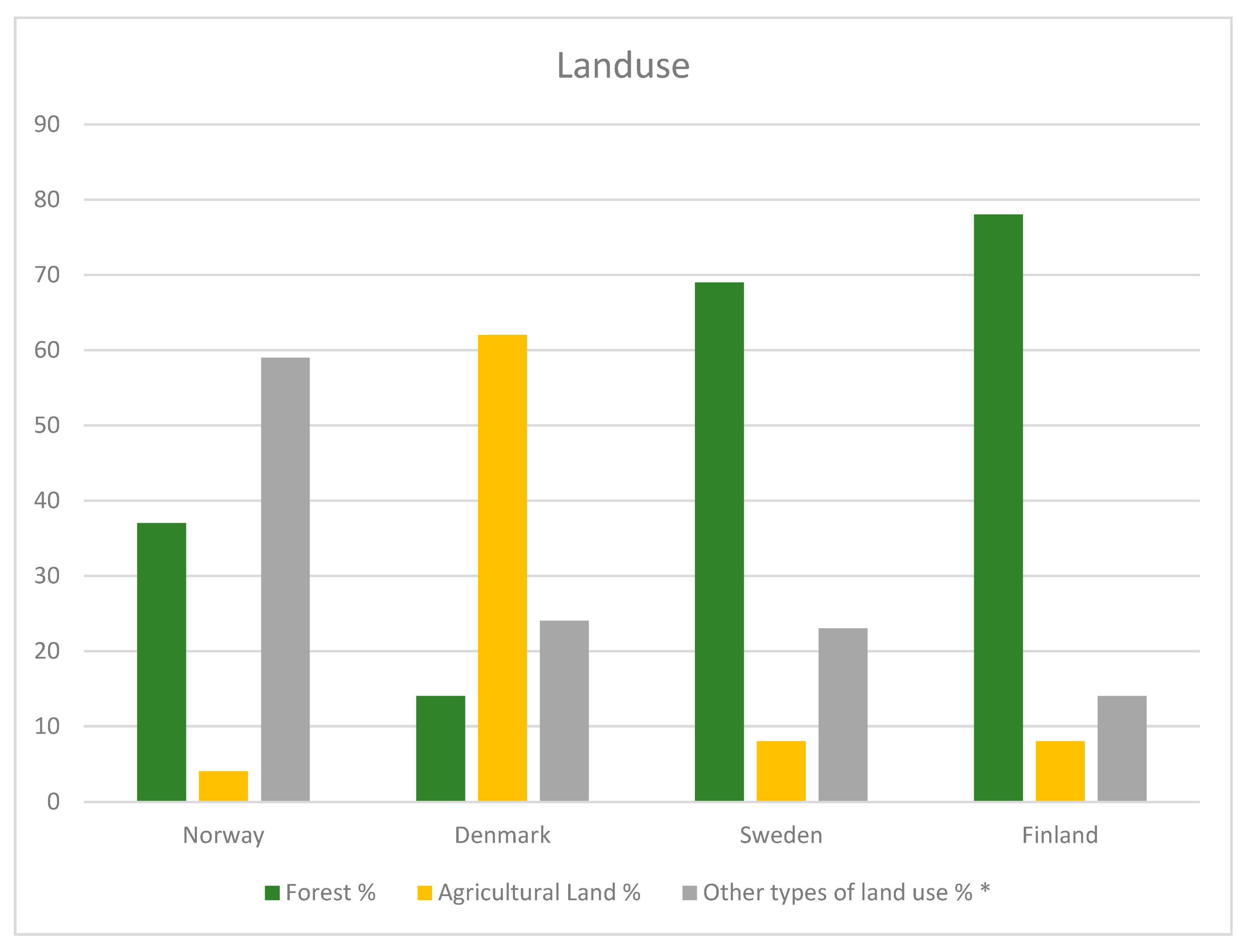
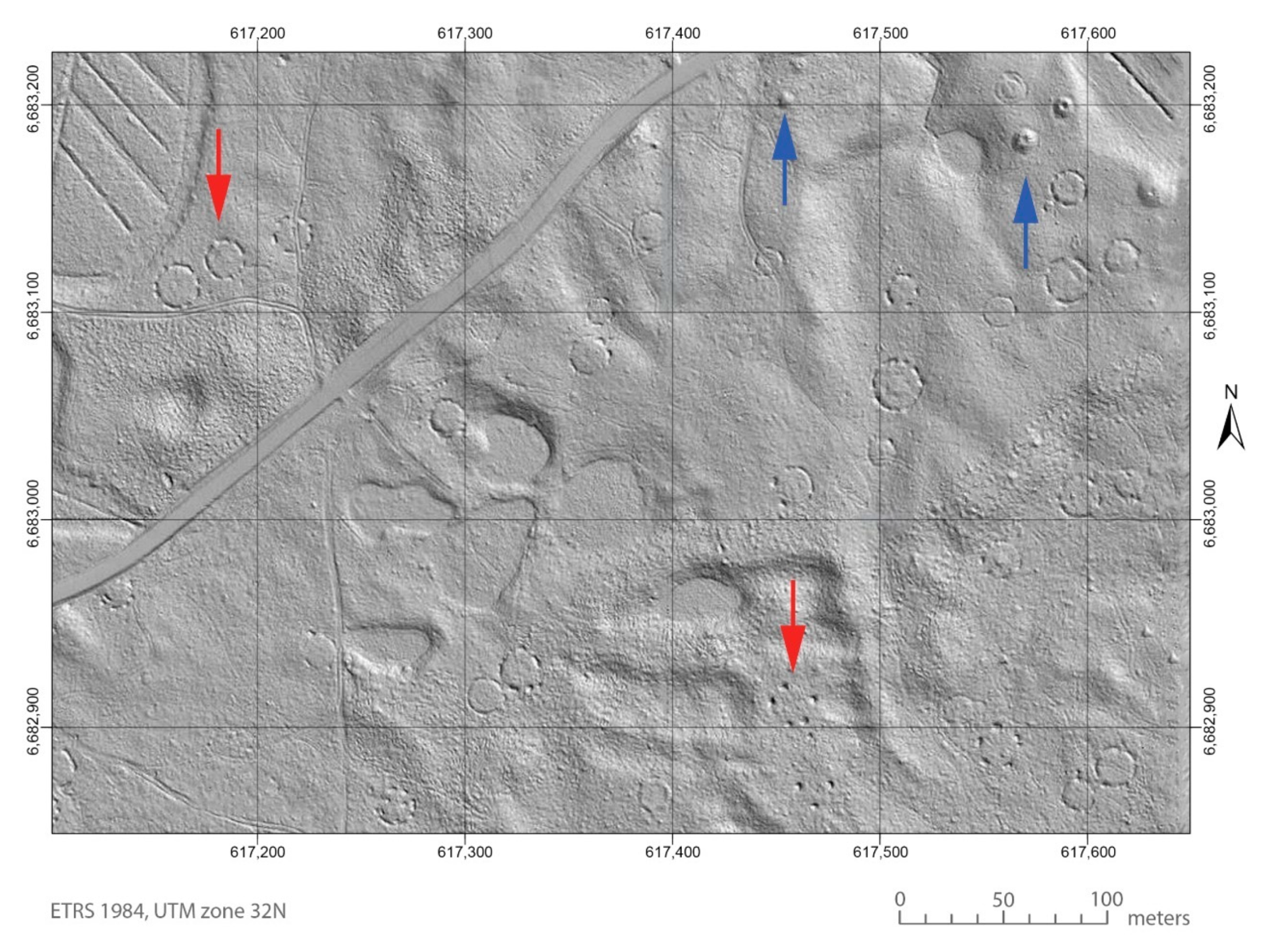

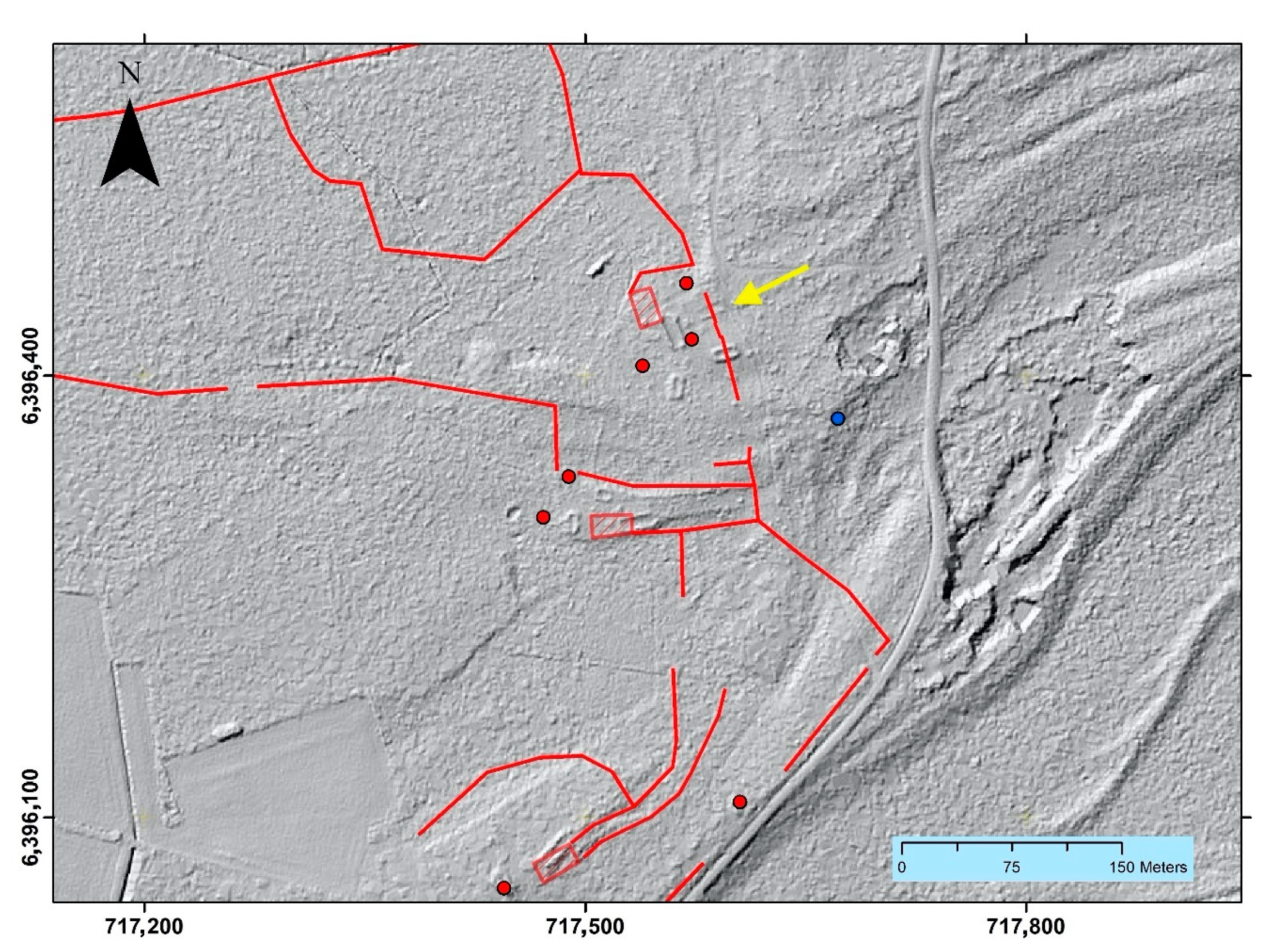

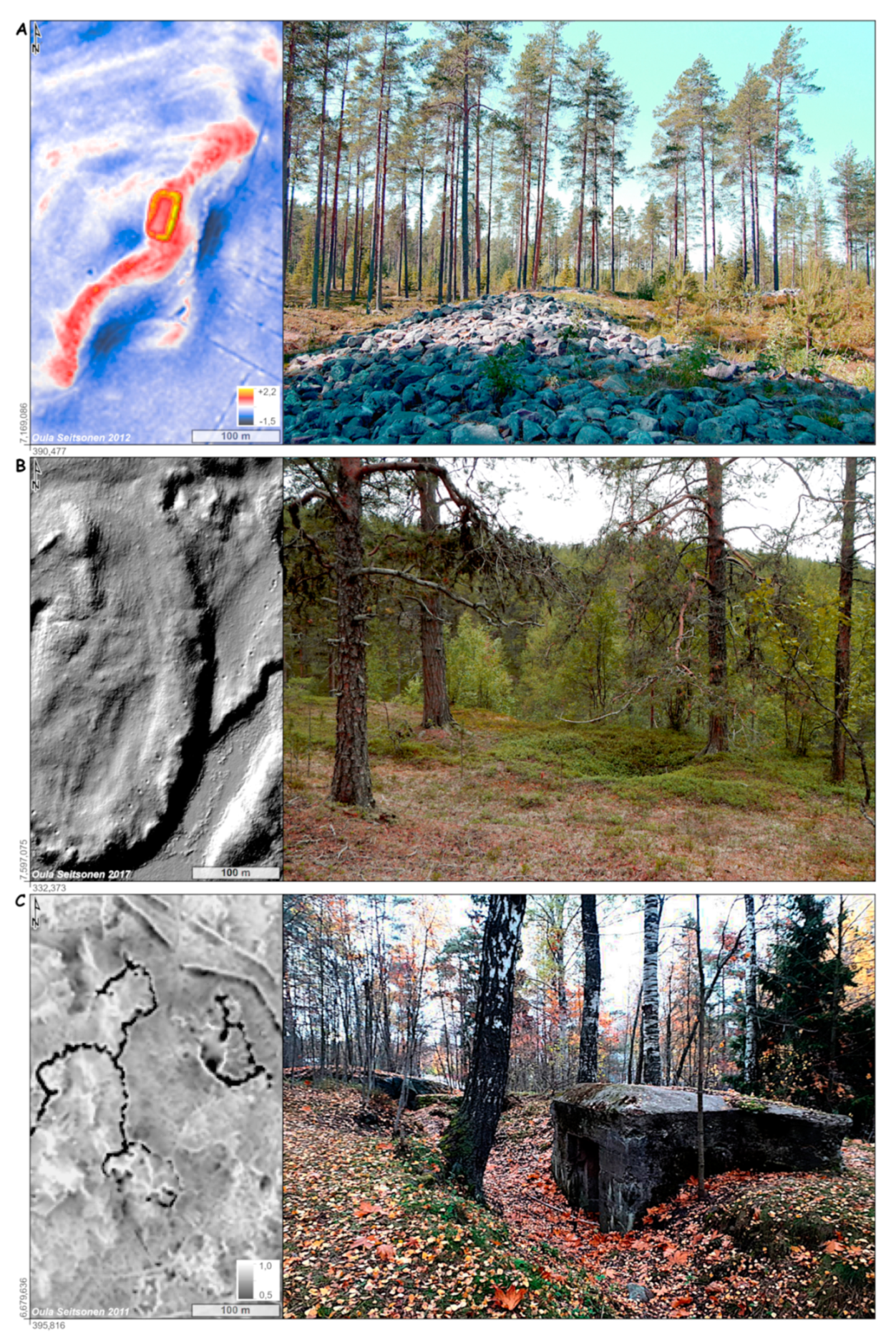
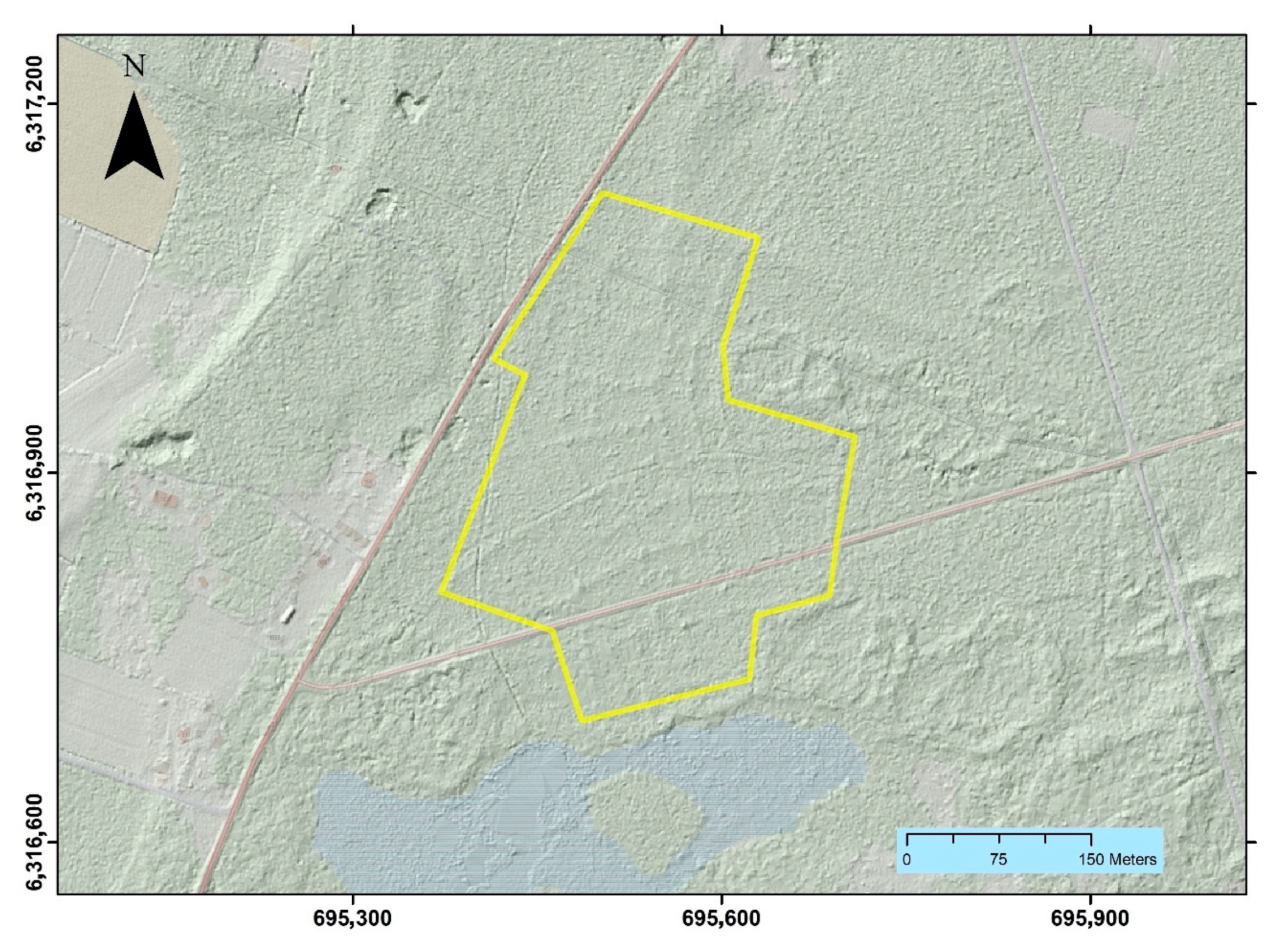
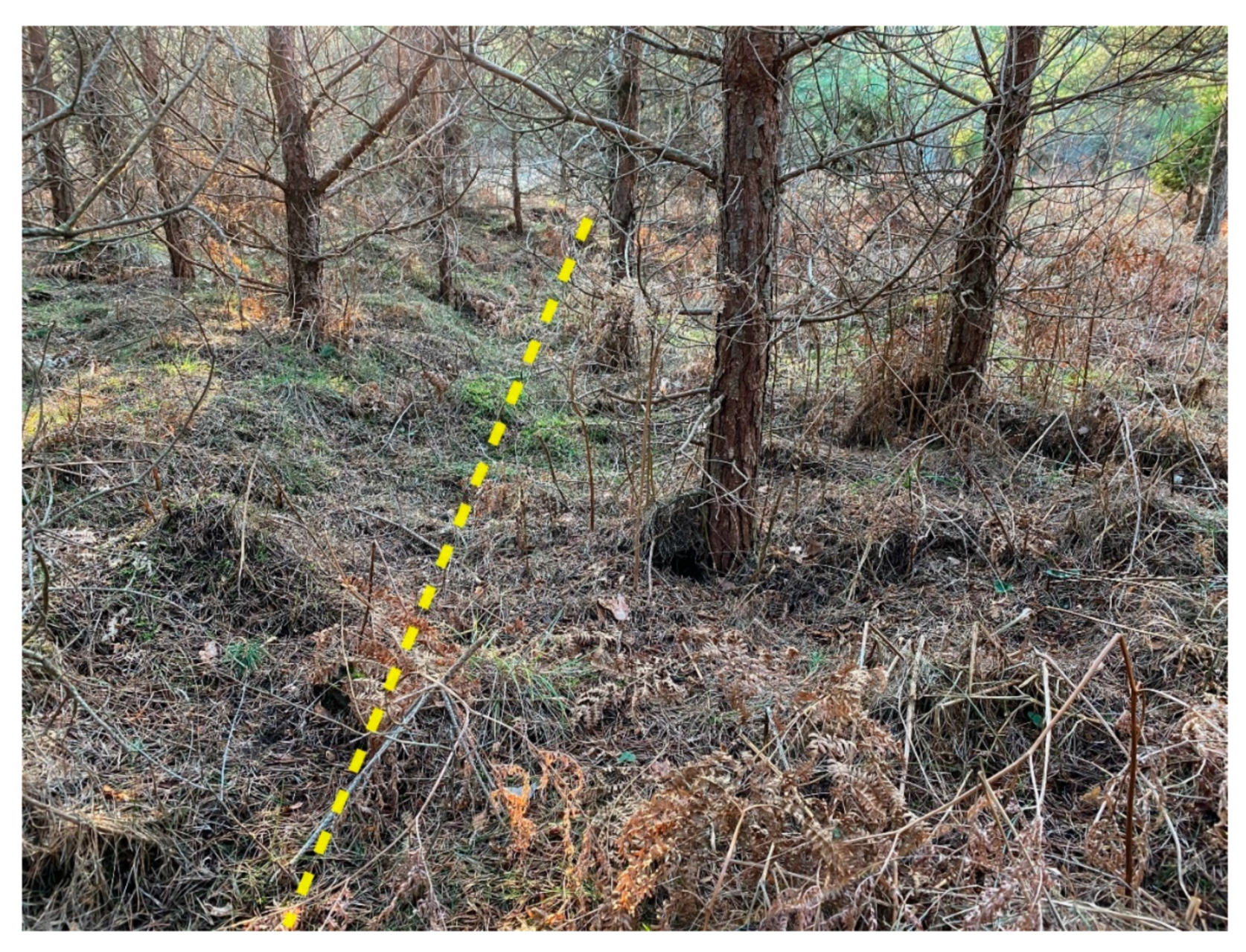



| Country | Acquisition Year | Points/m2 | Grid Size (m) | Open Access |
|---|---|---|---|---|
| Norway | 2011–2013 | 0.01 | 10 | Yes |
| Norway | 2016–2022 | 2 | 1 | Yes |
| Denmark | 2005–2007 | 0.45 | 1.6 | Yes |
| Denmark | 2014–2015 | 4–5 | 0.4 | Yes |
| Sweden | 2009–2019 | 0.5–1 | 1 | No |
| Sweden | 2018–present | 1–2 | - | Yes |
| Finland | 2008–2019 | 0.5 | 2 | Yes |
© 2020 by the authors. Licensee MDPI, Basel, Switzerland. This article is an open access article distributed under the terms and conditions of the Creative Commons Attribution (CC BY) license (http://creativecommons.org/licenses/by/4.0/).
Share and Cite
Risbøl, O.; Langhammer, D.; Schlosser Mauritsen, E.; Seitsonen, O. Employment, Utilization, and Development of Airborne Laser Scanning in Fenno-Scandinavian Archaeology—A Review. Remote Sens. 2020, 12, 1411. https://doi.org/10.3390/rs12091411
Risbøl O, Langhammer D, Schlosser Mauritsen E, Seitsonen O. Employment, Utilization, and Development of Airborne Laser Scanning in Fenno-Scandinavian Archaeology—A Review. Remote Sensing. 2020; 12(9):1411. https://doi.org/10.3390/rs12091411
Chicago/Turabian StyleRisbøl, Ole, Daniel Langhammer, Esben Schlosser Mauritsen, and Oula Seitsonen. 2020. "Employment, Utilization, and Development of Airborne Laser Scanning in Fenno-Scandinavian Archaeology—A Review" Remote Sensing 12, no. 9: 1411. https://doi.org/10.3390/rs12091411
APA StyleRisbøl, O., Langhammer, D., Schlosser Mauritsen, E., & Seitsonen, O. (2020). Employment, Utilization, and Development of Airborne Laser Scanning in Fenno-Scandinavian Archaeology—A Review. Remote Sensing, 12(9), 1411. https://doi.org/10.3390/rs12091411





